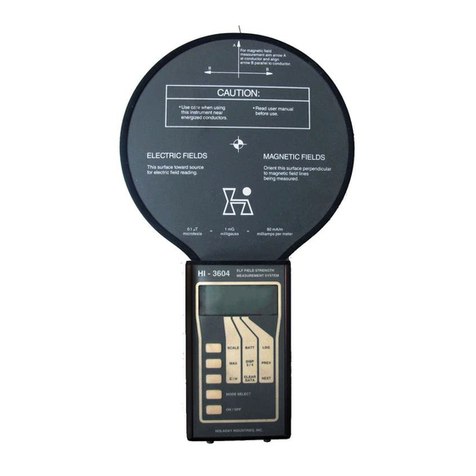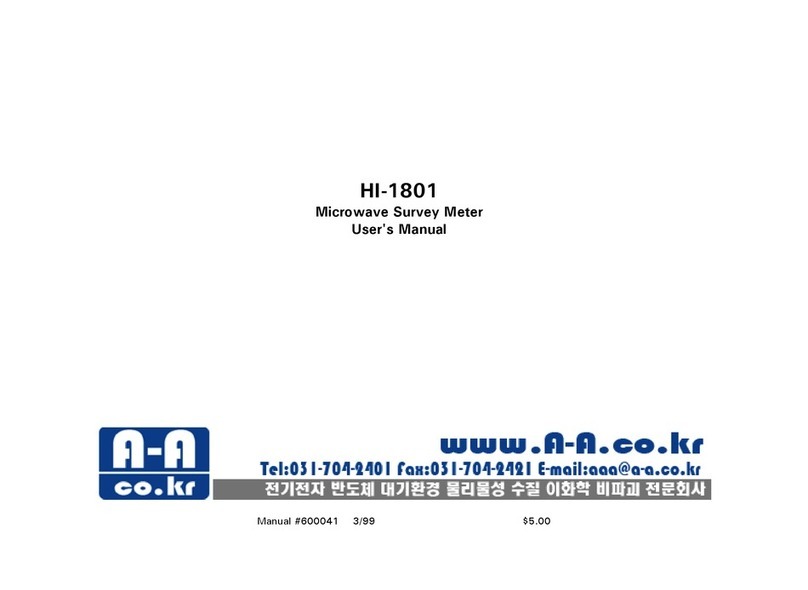LIMITED WARRANTY
HOLADAY INDUSTRIES, INC. WARRANTS EACH MODEL HI-3624 / HI-
3624A POWER FREQUENCY FIELD STRENGTH METER TO BE FREE FROM
DEFECTS IN MATERIAL AND WORKMANSHIP FOR A PERIOD OF ONE
YEAR FROM DATE OF SHIPMENT TO THE PURCHASER. THIS WARRANTY
EXTENDS TO THE ORIGINAL PURCHASER ONLY AND DOES NOT APPLY
TO BATTERIES OR ANY PRODUCT OR PARTS SUBJECT TO MISUSE,
NEGLECT, ACCIDENT, UNAUTHORIZED SERVICE OR ABNORMAL
CONDITIONS OF OPERATION.
IN THE EVENT OF INSTRUMENT FAILURE COVERED BY THIS WARRANTY,
HOLADAY INDUSTRIES, INC. WILL, WITHOUT CHARGE, REPAIR AND
RECALIBRATE THE INSTRUMENT IF RETURNED TO THEIR FACTORY
WITHIN ONE YEAR OF THE ORIGINAL PURCHASE, PROVIDED THAT
HOLADAY INDUSTRIES' EXAMINATION DISCLOSES TO ITS
SATISFACTION THAT THE PRODUCT WAS DEFECTIVE. HOLADAY
INDUSTRIES, INC. MAY, AT ITS OPTION, REPLACE THE PRODUCT IN
LIEU OF REPAIR. IF THE DEFECT WAS CAUSED BY MISUSE, NEGLECT,
ACCIDENT, UNAUTHORIZED SERVICE OR ABNORMAL CONDITIONS OF
OPERATIONS, REPAIRS WILL BE BILLED AT ANOMINAL COST. IN SUCH
CASE, AN ESTIMATE WILL BE PROVIDED BEFORE WORK IS STARTED IF
REQUESTED BY THE PURCHASER.
FOR WARRANTY SERVICE, CONTACT HOLADAY INDUSTRIES, INC.
GIVING FULL DETAILS OF THE FAILURE AND THE SERIAL NUMBER OF
THE INSTRUMENT. YOU WILL THEN BE GIVEN SERVICE INFORMATION
OR SHIPPING INSTRUCTIONS. RETURN THE INSTRUMENT TO THE
FACTORY TRANSPORTATION PREPAID. REPAIRS WILL BE MADE AT THE
FACTORY AND THE INSTRUMENT RETURNED TO YOU TRANSPORTATION
PAID. HOLADAY INDUSTRIES, INC. ASSUMES NO RESPONSIBILITY FOR
LOSS OF, OR DAMAGE TO, PRODUCTS IN TRANSIT.
WARNING
SPECIAL CAUTION IS ADVISED WHEN WORKING IN ENVIRONMENTS
WHERE CONTACT WITH HIGH VOLTAGE OR HIGH CURRENT CIRCUITS OR
APPARATUS IS POSSIBLE. THIS IS PARTICULARLY TRUE WHEN
ATTEMPTING TO OBTAIN ELECTRIC OR MAGNETIC FIELD STRENGTH
MEASUREMENTS IN CONFINED QUARTERS, FOR EXAMPLE INSIDE
CABINETS CONTAINING ELECTRICALLY OPERATED EQUIPMENT,
ELECTRIC POWER SUBSTATIONS OR IN VERY CLOSE PROXIMITY TO THE
CONDUCTORS OF ENERGIZED POWER LINES. ACCIDENTAL CONTACT
WITH OBJECTS OR CIRCUITS OPERATED AT HIGH VOLTAGES OR HIGH
CURRENTS CAN BE LETHAL! HOLADAY INDUSTRIES, INC. ASSUMES NO
LIABILITY FOR DAMAGES OR PERSONAL INJURY WHICH MAY RESULT
FROM ACCIDENTS ARISING OUT OF USE OF THIS EQUIPMENT.





























